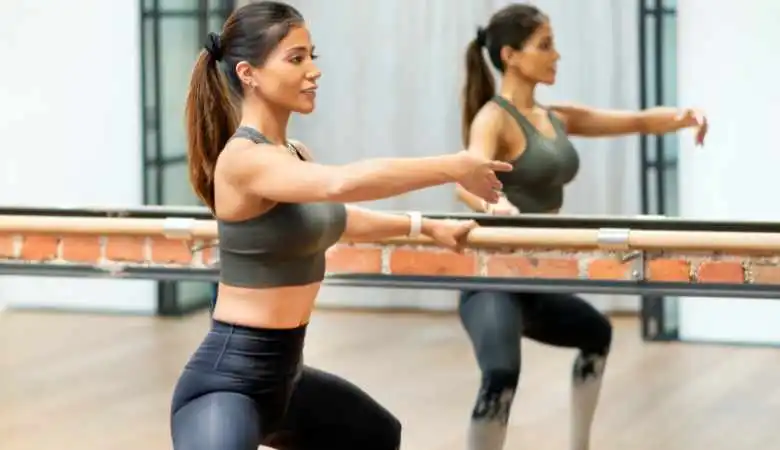In classical choreography, plie squats are the basis for complex movements. From ballet, the exercise came to sports, where bodybuilders appreciated its simplicity and benefits.
What is a Plie Squat?
The plie squat is an exercise in which your feet are wider than shoulder-width apart with your toes and knees turned outward. In this position, squatting occurs due to flexion of the knee joint and abduction of the pelvis. Plie is a ballet term for an identical dance movement.
The plie squat came into strength training from ballet. There, the plie looks a little different, but one important feature is the same: the feet and knees need to be turned at an angle of approximately 120°. In ballet, this is justified by the tasks of choreography and the historically established school of classical dance, but how many ballet steps are needed in the gym is a big question.
Most often, plie squats are shown as the best exercise for girls since it allows you to solve two problems at once: pump up your buttocks and tighten your inner thighs. From the point of view of physiology and biomechanics, these muscle groups are indeed strongly involved in plie squats. Still, you can train them without risks only if you have increased flexibility since childhood, especially in the hip joint.
If splits didn’t come quickly to you as a child, the best thing you can do in your training program is to give up plies, especially in the first months of training.
Instead, it would help if you learned basic squats, Romanian deadlifts, and lateral lunges. This way, the buttocks and inner thighs will be involved, and the risk of cumulative injuries will be minimized.
Plie Squats: What Muscles Work
The plie squat is not an essential but valuable exercise that can diversify your workout. Research has shown that, compared to classic squats, the plie puts more stress on the adductor longus muscle located on the anteromedial surface of the thigh.
The exercise is helpful for both men and women. It intensively loads the gluteal muscles, and due to the legs’ rotation, the thigh’s inner surface is also activated, which is rarely used unless there is an additional sports load. Such strength exercises affect not only the muscles: thanks to the inversion position, the range of motion of the knee joints increases. If you perform plie squats correctly, flexibility and mobility in your legs will noticeably improve over time.
Contraindications to Plie Squats
The muscle corset is very important for the body, especially for the lower extremities: After receiving an injury, the muscles quickly weaken: we begin to use the damaged area of the body less due to pain and other unpleasant symptoms.
The main contraindications for pelvic squats are the acute period of injury, the early postoperative period, and the inflammatory processes in the muscles and tendons involved in performing this exercise.
During plie squats, a large load falls on the knee joints. Therefore, changes in the cartilage of the patella or femur, chondromalacia (history of cartilage softening) and arthrosis are also contraindicated when performing the exercise. These conditions can exacerbate pain during exercise.”
Plie Squat Technique
To do a proper plie squat, you must stand straight with a straight back, place your feet about twice as wide as your shoulders, and point your toes away. Your hands can be placed on your belt or clasped in front of your chest. When you have secured a stable position, move your pelvis back, keep your back straight, and gradually bend your knees. They should be directed towards the toes and not curl inward. If this happens, your joints may lack mobility. In this case, place your feet narrower and gradually increase the space between your feet with each new workout.
Place your feet wider than your shoulders and turn them and your knees out to the sides as far as you can open your thigh at the hip joint. If your knee falls inward, your foot goes to the inside edge, and your little toe rises, these are signs that you lack mobility in the hip joint and you cannot yet turn your legs so widely to the sides.
As you inhale, squat down until your thighs are parallel to the floor, and as you exhale, rise to the starting position. At the lowest point, the buttocks and knees should be at the same height while maintaining a straight position of the back with natural curves – that is, the lower back maintains lordosis (bending the lumbar spine forward) and does not round and the shoulders are straightened. The gaze is directed forward. If you do not plan to lift the barbell with two body weights, try not to learn back squats immediately.
Once you have mastered the movement technique so that you don’t have to think about it, you can add loads to place more stress on the muscles. Nothing will happen to the muscles if you don’t add or change the load.”
In the future, you can try exercising with weights, such as picking up dumbbells or a suitable weight.
If you find yourself far from the gym, on vacation or at home, and the only equipment you have at hand is various elastic bands, you can do a plie squat in this version:
Strength training should be followed by stretching to prevent muscle shortening, relieve pain, increase flexibility, and reduce the risk of injury.


